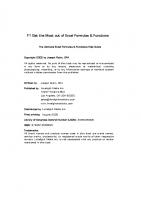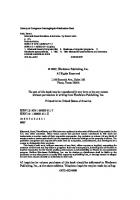EXCEL FORMULAS & FUNCTIONS 2023 2345000000
Do you need to perform challenging financial and mathematical calculations for a project? Did you know that you could pe
434 122 6MB
English Pages 316 Year 2022
Table of contents :
TABLE OF CONTENTS
INTRODUCTION
What do Excel formulas mean?
Exercise using formulas
When using Excel's formulae, watch out for these mistakes.
What in Excel is a function?
CHAPTER 1
FORMULAS AND FUNCTIONS
formulae that use operators
Examining the relationship between the operators in formulas
Formulas that use functions
Examples of function-based formulas
Function arguments
More information about functions
Manual entry of formulas
Formulae entered by pointing
Pasted formulas with range names
Adding functions to formulas
Function entry guidance
Editing Formulas
Using Cell References in Formulas
Referencing with mixed, relative, and absolute terms
Altering the references you use
Using cells outside the worksheet as references
Referencing cells from different workbooks
Cell Address
Making Use of Formulas in Tables
Data in a table being compiled
Using formulas within a table
Using a table's data as a reference
Correcting Common Formula Errors
Circular references management
Utilizing Advanced Naming Methods
Constant names are used
Using names for formulas
Using range intersections
Applying names to existing references
Calculating with the Formula bar
precise replication of a formula
Converting formulas to values
CHAPTER 2
APPLICATION OF FORMULAS TO REGULAR MATHEMATICAL ACTIVITIES
Percentage Calculations
determining the percentage of the target
Percentage variance calculation
% Variance calculation with negative values
How to compute a percent distribution
Running total calculation
Adding or subtracting items by a percentage
Dealing with divide-by-zero errors
Rounding Numbers
Rounding numbers using formulas
Rounding to the nearest penny
Rounding up to significant digits
A Range of Values Can Be Counted
Using the conversion functions in Excel
CHAPTER 3
MANIPULATING TEXT WITH FORMULAS
A Number That Isn't Handled Like a Number
Text-Based Functions
connecting text strings
Setting the text case for sentences
A text string's spaces are removed
Taking out specific text from a string
Finding a particular character in a text string
Tracking down a character's second appearance
Changing text strings
A cell's characters can be counted individually
A formula's line break can be added.
The removal of unusual characters from text fields
Using zeros to pad integers
Formatting a text string's numbers
CHAPTER 4
Utilizing Formulas with Dates and Times
Excel Date and Time Handling: An Understanding
Acquiring knowledge about date serial numbers
Select a Date System: 1900 Or 1904
Dates Entry
Browsing for Dates
knowledge of time serial numbers
Entering times
Manipulating times and dates
Challenges with dates
The leap year glitch in Excel
Pre-1900 dates
Dates that are inconsistent
Using Excel's Date and Time Functions
Getting the current date and time
Calculating age
Calculating the number of days between two dates
Calculating the number of workdays between two dates
Using NETWORKDAYS.INTL
Generating a list of business days excluding holidays
Extracting parts of a date
Calculating the number of years and months between dates
Converting dates to Julian date formats
Calculating the percent of the year completed and remaining
Returning the last date of a given month
Using the EOMONTH function
Calculating the calendar quarter for a date
Calculating the fiscal quarter for a date
Returning a fiscal month from a date
Calculating the date of the Nth weekday of the month
Calculating the date of the last weekday of the month
Portioning out a time
Calculating elapsed time
Rounding time values
Converting decimal hours, minutes, or seconds to a time
Adding hours, minutes, or seconds to a time
CHAPTER 5
CONDITIONAL ANALYSIS IMPLEMENTING FORMULAS
Conditional Analysis: An Overview
Verifying a straightforward condition is met
Multiple conditions are being checked
Confirming conditional data
Looking up values
Determining if both conditions 1 and 2 are satisfied
functions for text manipulation
Referring to logical conditions in cells
Checking if Condition1 OR Condition2 are met
Making conditional computations
Summing greater than zero
Adding up all figures that fall under two or more conditions
Summing if values fall between a given date range
Using SUMIFS
Getting a count of values that meet a certain condition
Counting values that satisfy two or more criteria
SUMIFS for summing multiple conditions.
finding unusual characters
Getting the average of all numbers that meet a certain condition
Getting the average of all numbers that meet two or more conditions
CHAPTER 6
APPLICATION OF MATCHING AND LOOKUPS FORMULAS
Explanation of Lookup Formulas
Using the Lookup Functions in Excel
Searching for a certain value using the left lookup column
Searching for a certain value using any lookup column
Looking up values horizontally
Hiding errors returned by lookup functions
The process of selecting the closest match from a list of banded values
The INDEX and MATCH functions are used to find the closest match.
Looking up values from multiple tables
Looking up a value based on a two-way matrix
Making use of default values to match
Calculating a value based on certain criteria
SUMPRODUCT is used to return text.
How to determine a column's latest value
Using LOOKUP, determining the final number
CHAPTER 7
APPLICATION OF FORMULAS TO FINANCIAL ANALYSIS
Making Regular Business Calculations
Gross profit margin and gross profit margin percentage calculations
Markup calculation
Calculating EBIT and EBITDA
Making a cost-of-sale calculation
Goods Available for Sale
Cost of Goods Sold
Calculating the asset return
How to calculate return on equity
Calculating break-even
Estimating customer churn
Computing the churn rate annually
The average client lifetime value calculation
Calculating employee turnover
Leveraging Excel's Financial Functions
Converting interest rates
Rate of Return on Investment
Nominal Interest Rate
Using FV to compute the effective rate
The development of a loan payment calculator
Creating an amortization schedule
Creating a variable-rate mortgage amortization schedule
Using dates instead of payment numbers
Making an accelerated depreciation calculation
Starting period
The present value calculation
Making a present-value calculation for future payments
Calculating the net present value
The calculation of both positive and negative cash flows
Internal rate of return calculation
Future non-periodic cash flows calculation
Performing financial forecasting
CHAPTER 8
APPLICATION OF FORMULAS IN STATISTICAL ANALYSIS
Working with Weighted Averages
Data Smoothing Using Moving Averages
Exponential smoothing applied to volatile data
How to Produce Descriptive Statistics Using Functions
Obtaining either the biggest or least value
Obtaining the Nth biggest or least value
Calculating mean, median, and mode
Data allocation into percentiles
Interquartile Range for Statistical Outlier Identification
Another helpful tool is Excel's QUARTILE function.
A replacement for the FREQUENCY function
CHAPTER 9
TABLES AND CONDITIONAL FORMATTING IN FORMULAS
Cells That Meet Specific Criteria Are Highlighted
Cells can be highlighted dependent on another cell's value.
Highlighting Values That Exist in List1 but Not List2
Highlighting Values That Exist in List1 and List2
Highlighting Based on Dates
Highlighting days between two dates
Using a due date to highlight dates
CHAPTER 10
COMPREHENSION AND USE OF ARRAY FORMULAS
Knowing how to use array formulas
An array with several cells
A single-cell array formula
How to Create an Array Constant
Identifying an Array's Dimensions
Horizontal arrays in one dimension
One-dimensional vertical arrays
Two-dimensional arrays
Naming Array Constants
Working with Array Formulas
Entering an array formula
Choosing a formula range for an array
Expanding or contracting a multicell array formula
THE CONTRARY OF ARRAY FORMULAS
Using Multicell Array Formulas
Creating an array from values in a range
Creating an array constant from values in a range
Performing operations on an array
Using functions with an array
Transposing an array
Making an array of sequential integers
Worksheet Functions That Return an Array
Using Single-Cell Array Formulas
Counting characters in a range
Summing the three smallest values in a range
Counting text cells in a range
The removal of intermediate formulas
Replacing a range reference with an array
CHAPTER 11
IMPROVE THE RELIABILITY OF YOUR FORMULAS
Detecting and fixing formula errors
Erroneous parentheses
USING FORMULA AUTOCORRECT
Cells are filled with hash marks
No cell is completely empty.
Characters with extra space
Formulas returning an error
TRACING ERROR VALUES
BE AWARE OF THE COLORS.
There is no calculation of formulas
Problems with decimal precision
“Phantom link” errors
Using Excel Auditing Tools
Identifying cells of a particular type
Viewing formulas
Tracing cell relationships
Identifying precedents
Identifying dependents
Tracing error values
Fixing circular reference errors
Using the background error-checking feature
Using Formula Evaluator
Another technique to assess a component of a calculation in Excel is to:
Searching and Replacement
Searching for information
Information replacement
Searching for formatting
Spell-checking your worksheets
Using AutoCorrect
Conclusion
INDEX
TABLE OF CONTENTS
INTRODUCTION
What do Excel formulas mean?
Exercise using formulas
When using Excel's formulae, watch out for these mistakes.
What in Excel is a function?
CHAPTER 1
FORMULAS AND FUNCTIONS
formulae that use operators
Examining the relationship between the operators in formulas
Formulas that use functions
Examples of function-based formulas
Function arguments
More information about functions
Manual entry of formulas
Formulae entered by pointing
Pasted formulas with range names
Adding functions to formulas
Function entry guidance
Editing Formulas
Using Cell References in Formulas
Referencing with mixed, relative, and absolute terms
Altering the references you use
Using cells outside the worksheet as references
Referencing cells from different workbooks
Cell Address
Making Use of Formulas in Tables
Data in a table being compiled
Using formulas within a table
Using a table's data as a reference
Correcting Common Formula Errors
Circular references management
Utilizing Advanced Naming Methods
Constant names are used
Using names for formulas
Using range intersections
Applying names to existing references
Calculating with the Formula bar
precise replication of a formula
Converting formulas to values
CHAPTER 2
APPLICATION OF FORMULAS TO REGULAR MATHEMATICAL ACTIVITIES
Percentage Calculations
determining the percentage of the target
Percentage variance calculation
% Variance calculation with negative values
How to compute a percent distribution
Running total calculation
Adding or subtracting items by a percentage
Dealing with divide-by-zero errors
Rounding Numbers
Rounding numbers using formulas
Rounding to the nearest penny
Rounding up to significant digits
A Range of Values Can Be Counted
Using the conversion functions in Excel
CHAPTER 3
MANIPULATING TEXT WITH FORMULAS
A Number That Isn't Handled Like a Number
Text-Based Functions
connecting text strings
Setting the text case for sentences
A text string's spaces are removed
Taking out specific text from a string
Finding a particular character in a text string
Tracking down a character's second appearance
Changing text strings
A cell's characters can be counted individually
A formula's line break can be added.
The removal of unusual characters from text fields
Using zeros to pad integers
Formatting a text string's numbers
CHAPTER 4
Utilizing Formulas with Dates and Times
Excel Date and Time Handling: An Understanding
Acquiring knowledge about date serial numbers
Select a Date System: 1900 Or 1904
Dates Entry
Browsing for Dates
knowledge of time serial numbers
Entering times
Manipulating times and dates
Challenges with dates
The leap year glitch in Excel
Pre-1900 dates
Dates that are inconsistent
Using Excel's Date and Time Functions
Getting the current date and time
Calculating age
Calculating the number of days between two dates
Calculating the number of workdays between two dates
Using NETWORKDAYS.INTL
Generating a list of business days excluding holidays
Extracting parts of a date
Calculating the number of years and months between dates
Converting dates to Julian date formats
Calculating the percent of the year completed and remaining
Returning the last date of a given month
Using the EOMONTH function
Calculating the calendar quarter for a date
Calculating the fiscal quarter for a date
Returning a fiscal month from a date
Calculating the date of the Nth weekday of the month
Calculating the date of the last weekday of the month
Portioning out a time
Calculating elapsed time
Rounding time values
Converting decimal hours, minutes, or seconds to a time
Adding hours, minutes, or seconds to a time
CHAPTER 5
CONDITIONAL ANALYSIS IMPLEMENTING FORMULAS
Conditional Analysis: An Overview
Verifying a straightforward condition is met
Multiple conditions are being checked
Confirming conditional data
Looking up values
Determining if both conditions 1 and 2 are satisfied
functions for text manipulation
Referring to logical conditions in cells
Checking if Condition1 OR Condition2 are met
Making conditional computations
Summing greater than zero
Adding up all figures that fall under two or more conditions
Summing if values fall between a given date range
Using SUMIFS
Getting a count of values that meet a certain condition
Counting values that satisfy two or more criteria
SUMIFS for summing multiple conditions.
finding unusual characters
Getting the average of all numbers that meet a certain condition
Getting the average of all numbers that meet two or more conditions
CHAPTER 6
APPLICATION OF MATCHING AND LOOKUPS FORMULAS
Explanation of Lookup Formulas
Using the Lookup Functions in Excel
Searching for a certain value using the left lookup column
Searching for a certain value using any lookup column
Looking up values horizontally
Hiding errors returned by lookup functions
The process of selecting the closest match from a list of banded values
The INDEX and MATCH functions are used to find the closest match.
Looking up values from multiple tables
Looking up a value based on a two-way matrix
Making use of default values to match
Calculating a value based on certain criteria
SUMPRODUCT is used to return text.
How to determine a column's latest value
Using LOOKUP, determining the final number
CHAPTER 7
APPLICATION OF FORMULAS TO FINANCIAL ANALYSIS
Making Regular Business Calculations
Gross profit margin and gross profit margin percentage calculations
Markup calculation
Calculating EBIT and EBITDA
Making a cost-of-sale calculation
Goods Available for Sale
Cost of Goods Sold
Calculating the asset return
How to calculate return on equity
Calculating break-even
Estimating customer churn
Computing the churn rate annually
The average client lifetime value calculation
Calculating employee turnover
Leveraging Excel's Financial Functions
Converting interest rates
Rate of Return on Investment
Nominal Interest Rate
Using FV to compute the effective rate
The development of a loan payment calculator
Creating an amortization schedule
Creating a variable-rate mortgage amortization schedule
Using dates instead of payment numbers
Making an accelerated depreciation calculation
Starting period
The present value calculation
Making a present-value calculation for future payments
Calculating the net present value
The calculation of both positive and negative cash flows
Internal rate of return calculation
Future non-periodic cash flows calculation
Performing financial forecasting
CHAPTER 8
APPLICATION OF FORMULAS IN STATISTICAL ANALYSIS
Working with Weighted Averages
Data Smoothing Using Moving Averages
Exponential smoothing applied to volatile data
How to Produce Descriptive Statistics Using Functions
Obtaining either the biggest or least value
Obtaining the Nth biggest or least value
Calculating mean, median, and mode
Data allocation into percentiles
Interquartile Range for Statistical Outlier Identification
Another helpful tool is Excel's QUARTILE function.
A replacement for the FREQUENCY function
CHAPTER 9
TABLES AND CONDITIONAL FORMATTING IN FORMULAS
Cells That Meet Specific Criteria Are Highlighted
Cells can be highlighted dependent on another cell's value.
Highlighting Values That Exist in List1 but Not List2
Highlighting Values That Exist in List1 and List2
Highlighting Based on Dates
Highlighting days between two dates
Using a due date to highlight dates
CHAPTER 10
COMPREHENSION AND USE OF ARRAY FORMULAS
Knowing how to use array formulas
An array with several cells
A single-cell array formula
How to Create an Array Constant
Identifying an Array's Dimensions
Horizontal arrays in one dimension
One-dimensional vertical arrays
Two-dimensional arrays
Naming Array Constants
Working with Array Formulas
Entering an array formula
Choosing a formula range for an array
Expanding or contracting a multicell array formula
THE CONTRARY OF ARRAY FORMULAS
Using Multicell Array Formulas
Creating an array from values in a range
Creating an array constant from values in a range
Performing operations on an array
Using functions with an array
Transposing an array
Making an array of sequential integers
Worksheet Functions That Return an Array
Using Single-Cell Array Formulas
Counting characters in a range
Summing the three smallest values in a range
Counting text cells in a range
The removal of intermediate formulas
Replacing a range reference with an array
CHAPTER 11
IMPROVE THE RELIABILITY OF YOUR FORMULAS
Detecting and fixing formula errors
Erroneous parentheses
USING FORMULA AUTOCORRECT
Cells are filled with hash marks
No cell is completely empty.
Characters with extra space
Formulas returning an error
TRACING ERROR VALUES
BE AWARE OF THE COLORS.
There is no calculation of formulas
Problems with decimal precision
“Phantom link” errors
Using Excel Auditing Tools
Identifying cells of a particular type
Viewing formulas
Tracing cell relationships
Identifying precedents
Identifying dependents
Tracing error values
Fixing circular reference errors
Using the background error-checking feature
Using Formula Evaluator
Another technique to assess a component of a calculation in Excel is to:
Searching and Replacement
Searching for information
Information replacement
Searching for formatting
Spell-checking your worksheets
Using AutoCorrect
Conclusion
INDEX

- Similar Topics
- Computers
- Algorithms and Data Structures
- Commentary
- EXCEL FORMULAS & FUNCTIONS 2023, Essential and Complete Excel Mastery Manual, Beginners and Pros







